They’re colorful, packed with sturdy legs, tend to be furry, and somewhat robust. But it is their gravity-defying skills that have earned them a name for themselves “Jumping spiders”.
Known to leap at prey and immobilize it, jumping spiders or the Salticidae are considered one of the most agile species of arachnids known to science.
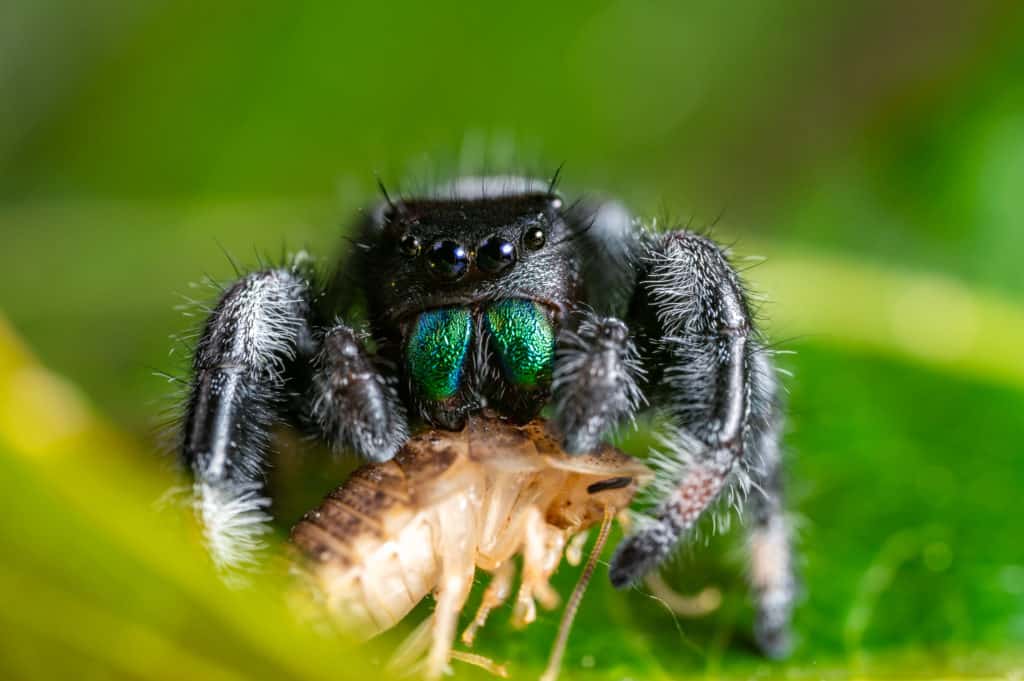
Jumping spiders eat a wide variety of foods. Their prey includes ants, dragonflies, grasshoppers, mosquitoes, webworms even other spiders. Some species will feed on vertebrates such as frogs and lizards. Strangley some jumping spiders also eat nectar as well, making them omnivores.
These skilled hunters are capable of leaping on an insect and avoiding its mandibles before immobilizing it and settling down to feed.
There’s much more to these fascinating spiders which have intrigued amateur and professional entomologists alike. Do they spin webs? How do they dispatch their prey? Are they capable of taking on other spiders or larger foes? So what type of prey is likely to incite a jumping spider to pounce in its direction? In other words, what do they love to eat?
To find out, we picked the brains of experts on arthropods and arachnids.
Read on to discover what you need to know about the one arachnid species that is a favorite among arthropod enthusiasts everywhere.
Jumping Spiders At A Glance
The Jumping Spiders Background And Physical Features
Arthropods in this category belong to a pretty large family of spiders, the largest of them all, in fact. There are about 5,000 species of jumping spiders (300 of which call North America home).
They are noted for their distinct abdomens and thoraxes, bright colors, and the fact that they can live in just about any environment: the tropics, temperate regions, mountain slopes, and even arid zones as well.
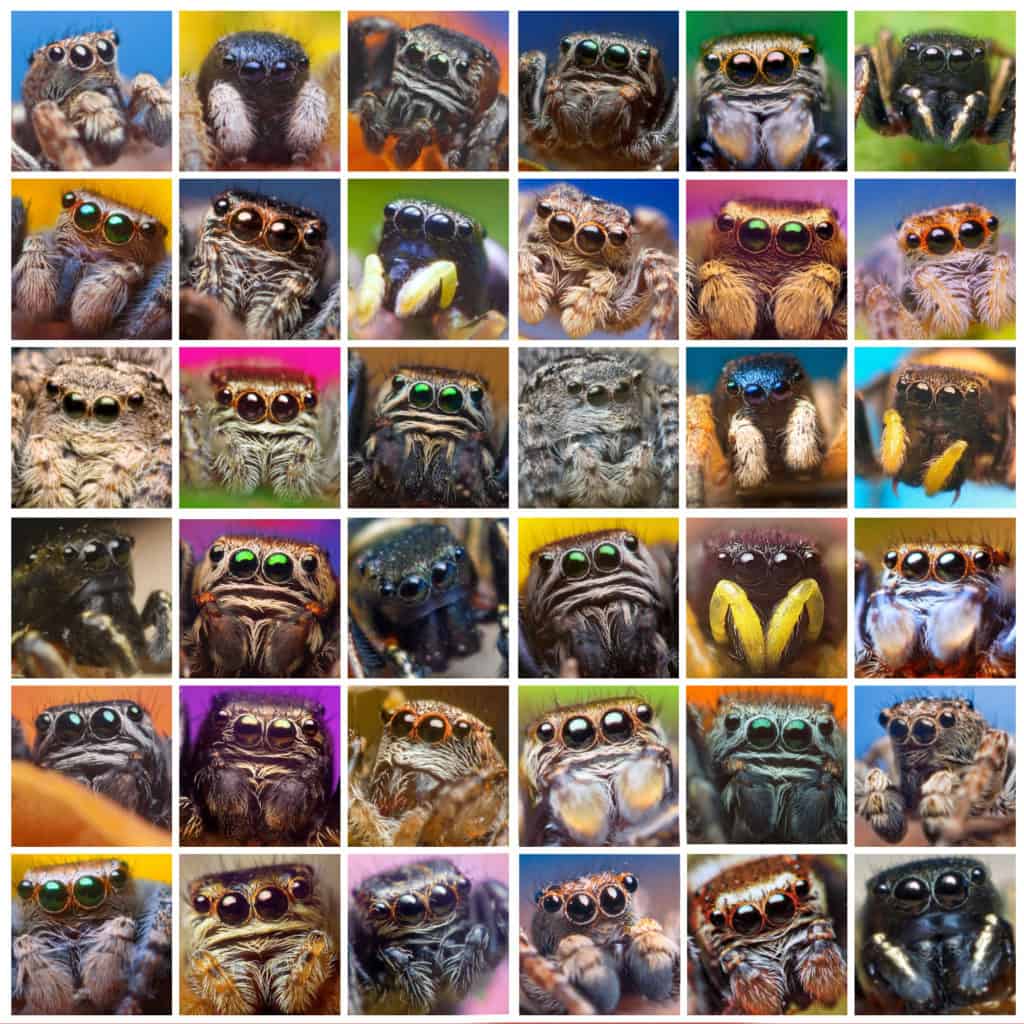
Certain species such as the Phidippus audax and the Phidippus regius also have especially colorful chelicerae, i.e., mouthparts that double as fangs and pincers, which serve to sting, immobilize and chop up prey for further consumption. In terms of size, they are the biggest of the entire spider family, and the largest of them is about an inch long.
If you live in Michigan or Utah and are interested to know what spiders you might run into then check out these articles we have written, Spiders You Might Find in Michigan. A Complete Guide and What Spiders Can Be Found in Utah and How Many Are Poisonous?
Jumping Spiders Have Exceptional Abilities
Jumping spiders’ main claim to fame is their ability to leap long distances while making use of a silken thread to hold them in position, just in case things go awry (such as their prey budging at the last second.)
The Phidippus audax is capable of jumping anywhere between 10 to 50 times its own length, an athletic feat that is simply beyond the capability of humans.
The ability to leap long distances is by no means their only remarkable feature, as they also have impressive eyesight and are capable of spotting prey at a distance of eight inches.
Jumping spiders are also pretty curious and are likely to stare right back at you rather than scurry off in fright.
How can you tell if one’s certainly looking at you? By just how dark their eyes turn, at their darkest, they’re absolutely focusing on you alone.
The Habits And Lifestyle Of Jumping Spiders
Most jumping spiders are tropical although several other species can be found on every other continent with the exception of Antarctica.
They also tend to remain active during the day and may strictly hunt prey or indulge in a taste of nectar if they feel like it. In addition to their preference for insects, some of them will also dine on their own kind.
A species known as the Bagheera Kiplingi is known to feed mostly on nectar and Beltian bodies. Beltian bodies are found on the tips of some leaves of acacia trees. These tips secret oils and proteins that are nutritious to ants as well as the Bagheera Kiplingi jumping spider.
On a side note, the nectar honey bees get from acacia trees make great-tasting honey. We have a whole series of articles on varieties of honey if you are interested, Honey Varieties You Should Discover.
Jumping spiders are not particularly known for web-spinning although they do spin cozy cocoons to protect themselves and their young from the elements.
In order to attract females, males entertain them with a dance following which they get to mate if the female is suitably impressed by their performance.
Can Jumping Spiders Make A Web?
Jumping spiders are capable of spinning silk. That said they do not spin webs for the purposes of netting their prey like certain other species are known to do.
They however love to spin cozy havens that serve as nests for hibernation, laying their eggs, and enjoying some much-needed downtime.
The arachnids also rely on a thread as an anchor of sorts when about to pounce on their prey or when abseiling down a considerable height.
How Do Jumping Spiders Kill Their Prey?
Unlike some of their relatives which prefer to spin a web and let their dinner come to them, jumping spiders prefer a more proactive approach.
Once they find an ant or a grasshopper, they think will make a tasty snack, they stalk it in a manner certain experts have compared to cats hunting prey. When close enough, they attach themselves to a silken cord (just in case) and launch themselves at their prey.
These enthusiastic hunters kill their victims in pretty much the same way their other relatives do, by immobilizing them with a poisonous jab and drenching them in their digestive juices before sucking in the satisfying, nutritious pulp.
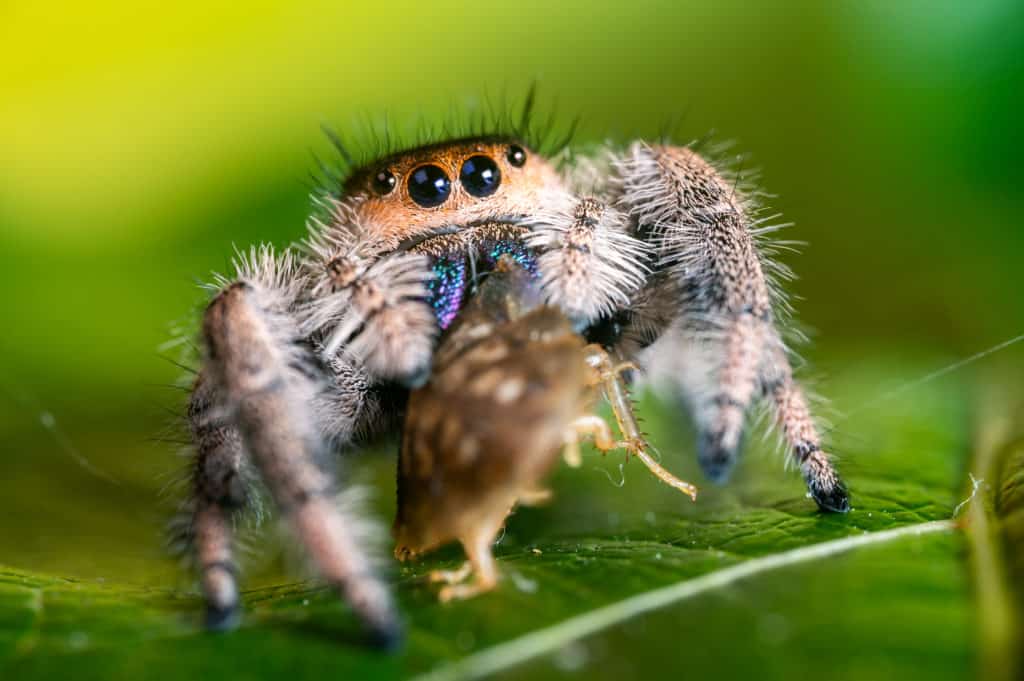
Can Jumping Spiders Kill Other Spiders?
Yes, they can. Like several other species (e.g., cellar spiders and spitting spiders), jumping spiders will help themselves to their fellow eight-legged arthropods where possible.
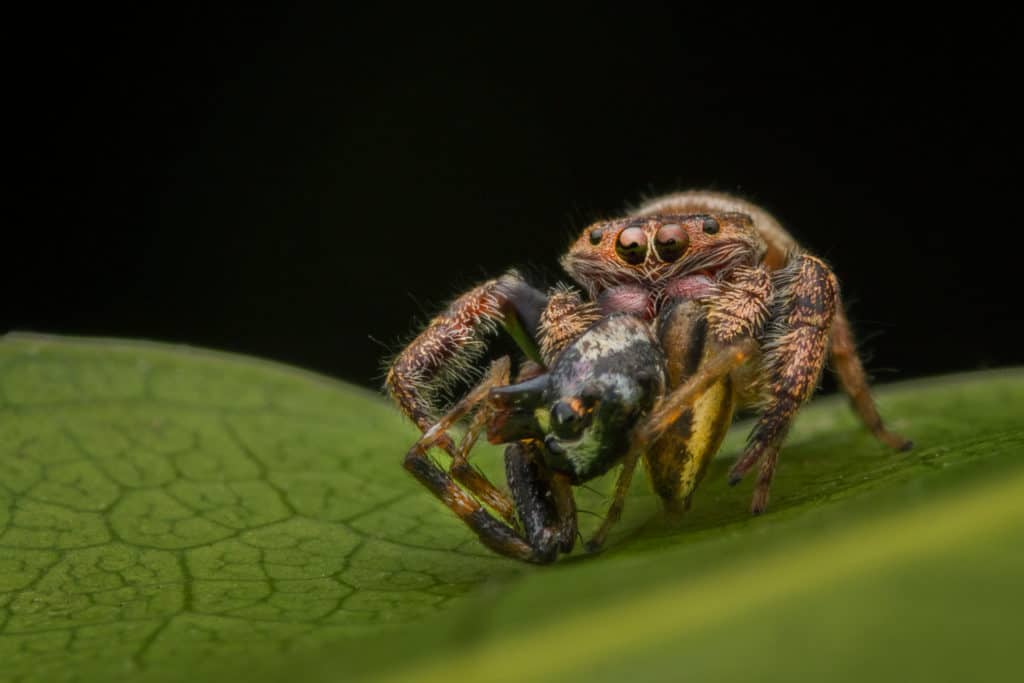
An example of a member of this vast family that is rather partial to its fellow arachnids is the Portia spider.
Arthropods in this category are renowned for luring other spiders to come a bit closer by wriggling energetically in their web and then jabbing the would-be-hunter with a bit of venom, and helping themselves to the victim.
It is an endeavor that requires considerable patience and smarts, and unsurprisingly, these spiders are considered to be one of the most intelligent arachnids out of the entire eight-legged collective.
If you are interested we do have a detailed article on the diets of spiders with pictures of them consuming their prey. The article is called, What Do Spiders Eat?
Can Jumping Spiders Kill Insects That Are Bigger Than Them?
Yes, they can. A key example is the regal jumping spider which is known to take on and subdue larger creatures such as grasshoppers and even dragonflies which are known to be the scourge of other arthropods.
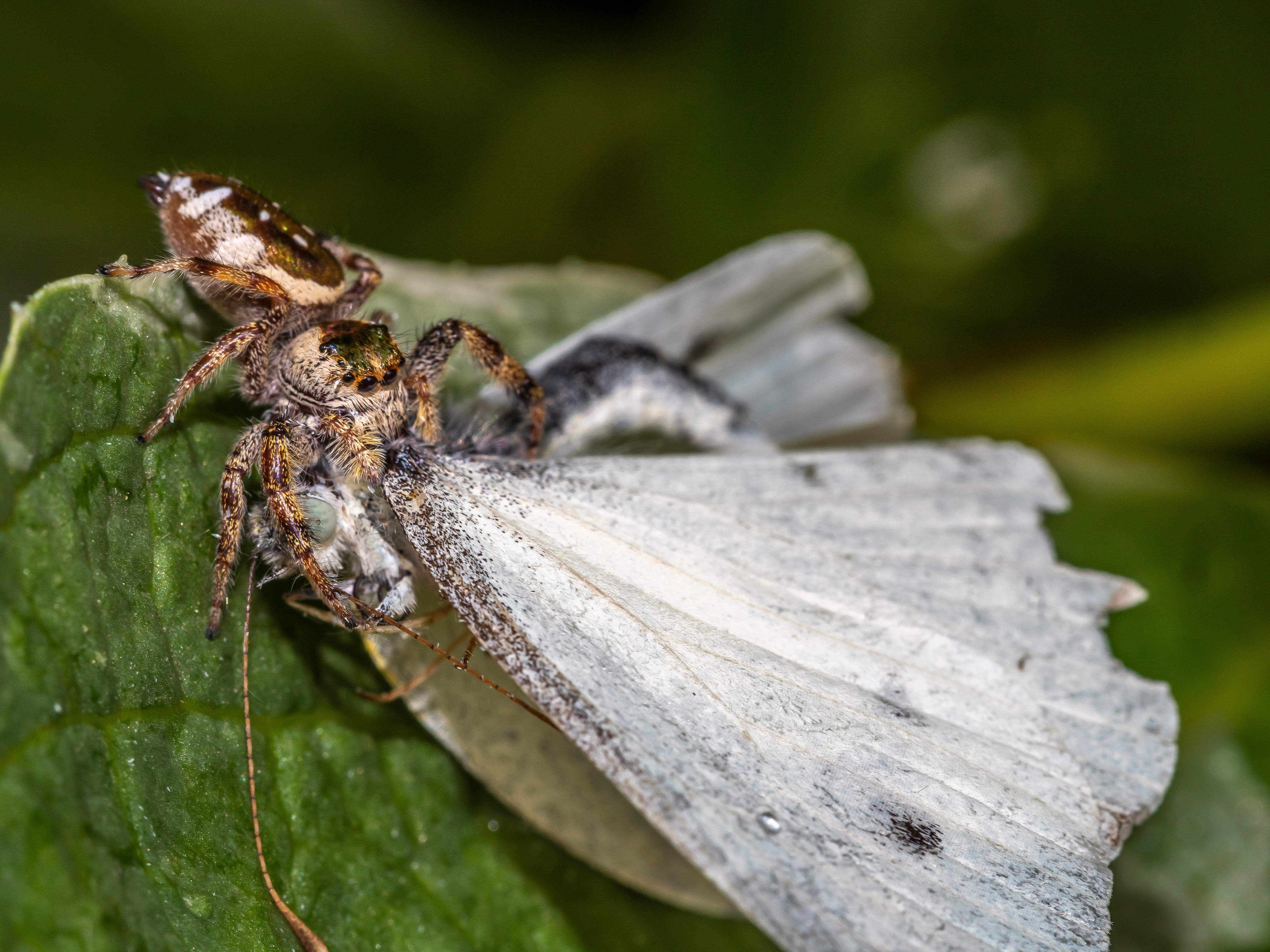
But the proof of just how powerful they are can be seen in their ability to actually swap positions on the food chain with some of their main predators: lizards and frogs.
Owing to their powerful venom, regal jumping spiders have been spotted feeding on reptiles and amphibians in a classic twist in which the hunter becomes the prey.
Do Jumping Spiders Hunt During The Day Or At Night?
Members of this vast family tend to be especially active during the daytime. As a result, you might be able to spot one simply lying in wait for an unsuspecting garden bug to saunter along, or even watch as it actively stalks and subdues a fellow spider.
This isn’t necessarily the case with all spiders. We do have two articles that take a close look at different aspects of how day, night, and even artificial light effects spider hunting activity. These are the articles if you are interested, Are Spiders Nocturnal? and Are Spiders Attracted to Light?
Can Jumping Spiders Control Unwanted Pests In Your Home?
In light of the fact that jumping spiders are intrepid little hunters, they can play a role in reducing the population of household insects or other arthropods that may wander into your home.
This especially holds true since they love to feed on ants, millipedes, centipedes, and moths, and tend to hang around doors, windows, or brightly lit spots.
However, jumping spiders generally prefer the outdoors and so do not have a habit of living in houses (although they may be tempted to enter your home if they notice an abundance of insects or creatures which are included in their diet).
Do Jumping Spiders Eat Ants?
Jumping spiders belong to the category of spiders that finds ants to be a protein-rich, tasty treat. The spider leaps at the victim while taking great care to avoid getting snapped at by the ant’s formidable pincers or getting jabbed by its sting.
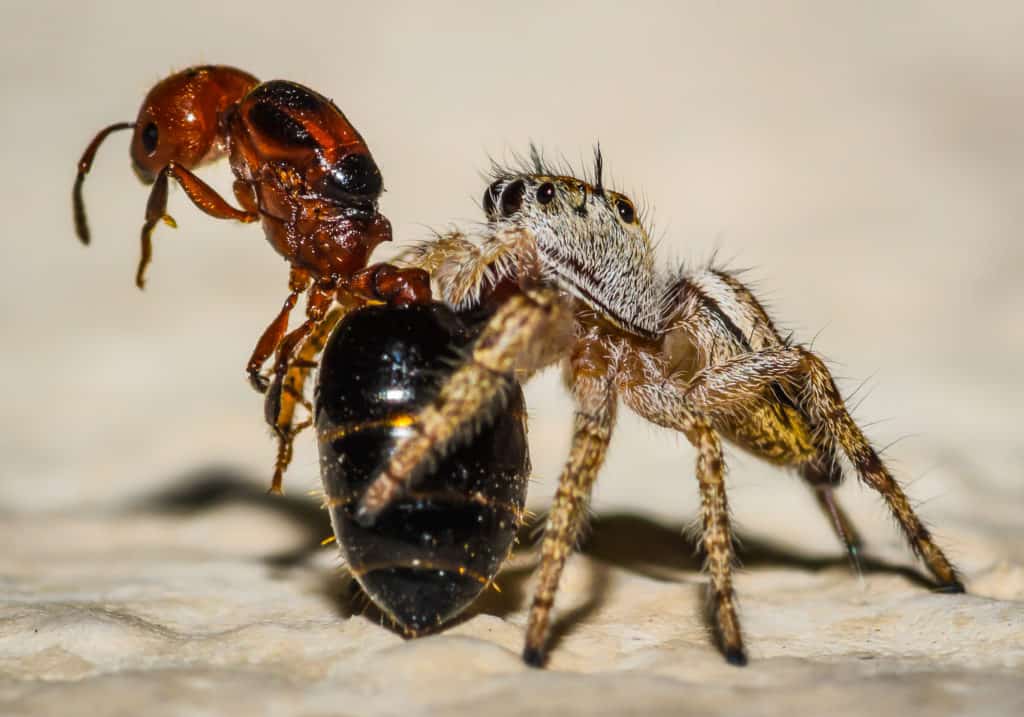
One such species known to feed on ants quite regularly is the twin flagged jumping spider which is known to grasp potential victims by the back of their heads or at their thoraxes before killing and consuming them.
If you are interested to know if there are any other spiders that also eat ants then check out this article we have written, Do Spiders Eat Ants?
The Wrap Up
Jumping spiders generally enjoy a varied diet which may include the plant material, insects (ants, butterflies, grasshoppers, and dragonflies), other arthropods (centipedes, millipedes, and spiders), and even reptiles and amphibians (frogs and lizards).
As their name suggests, they tend to actively hunt their prey, leaping at them, pinning them down, and dispatching them before settling down to a nourishing meal. That said, a number of them also pretend to be insects that have fallen into a spiders’ web to trick the patiently waiting occupant into walking over to take a closer look.
But these spiders are much more than their athletic ability and have also earned a reputation for their excellent eyesight and intelligence — they can actually be trained to do a few simple tricks.
Unsurprisingly these extraordinary arachnids have gained quite a few fans and several enthusiasts even keep them as pets as well.
Sources
https://www.livescience.com/54054-plant-eating-spiders-revealed.html
https://menunkatuck.org/tiny-jumping-spiders-are-endearing-predators
https://www.canr.msu.edu/resources/jumping-spider
https://www.nationalgeographic.com/news/2017/08/jumping-spiders-lizards-frogs-predators/
